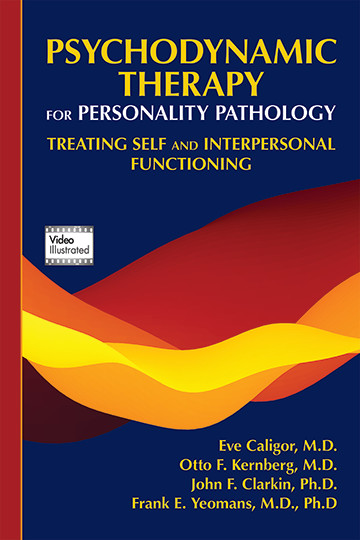A scientific psychotherapy has clearly delineated theory, reasonable evidence of effectiveness, and a practically characterized technique that is specifically linked to the theory and data. Transference-focused therapy–extended, the latest and most comprehensive iteration of the work of Eve Caligor, Otto Kernberg, John Clarkin, and Frank Yeomans, meets these criteria and is arguably the flagship for psychodynamic therapy in the contemporary era.
Their most recent book mines the productive vein of work begun by Kernberg that brings together succinct observation and description of subtle interpersonal phenomena, a gift for classification, commitment to the object relations model, and a unique ability to bridge theory and observed behavior. It is even grander in scope than the previous works by these authors and ties them together.
Transference-focused therapy–extended lays out a theory of personality and personality disorder and a treatment for conditions ranging from subclinical personality disorder to neurotic-level personality organization to high, middle, and low levels of borderline personality organization. The book is comprehensive, thorough, extraordinarily well organized, studded with meaningful clinical examples, anchored in outcome data, and well illustrated by associated video materials on the publisher’s web site.
The unit of study here is the internal object relation, defined as “a mental representation of a relationship pattern consisting of a representation of the self, referred to as a
self representation, interacting with a representation of another, referred to as an
object representation, linked to a particular affect state” (
1). This building block of subjective life is observed, explored, verbalized, and reflected upon in this therapy. It’s the theory and the praxis. Relationships are everything, and earlier ones impinge on current ones. The central focus of the therapy is on catching these profound relational drivers of experience through exploratory techniques, especially close attention to transference and countertransference engagement, and bringing them to awareness to tame them. Caligor and colleagues express these fundamental principles well and balance their general description with examples of the endless variations in how internal object relations express themselves in the sorrows our patients bring to us.
A strength of the model, and of the book, is its consistent attention to the psychological level of function of the patient. Everything is understood in the context of the level of organization of the personality. Tables identifying the features of patients on various levels of function—neurotic personality organization and three levels of borderline function—go beyond the typical observations about identity coherence and object permanence to describe many more nuanced and specific anchor points.
Each topic taken up in the book—assessment of personality, establishing the treatment frame, techniques and tactics—is considered at length, with a differential approach depending on the patient’s level of function. Not surprisingly, given the therapy’s special focus on the therapeutic relationship, the chapter on understanding transference and countertransference in patients with neurotic and borderline personality organizations is especially outstanding and includes 20 striking clinical illustrations.
The section on establishing the treatment frame, often a source of anxiety for a therapist taking on a patient with personality disorder (except when we respond to our anxiety by avoiding defining the frame clearly), is enormously useful. The authors distinguish between universal aspects of the treatment contract, including logistics, frequency, and responsibilities of the patient and therapist, and those aspects that are individual, such as specific disruptive, destructive, and dependent behavior risks. Their perspective is empowering to the therapist and a reminder of both our humility and the importance of structure in psychotherapy.
Because a picture is worth a thousand words, and a video at least an order of magnitude more, the associated video clips on the APA Publishing web site make all of these ideas come to life and, as a bonus, allow us to meet the authors and get a feel for them. The videos illustrate assessment, treatment contracting, identifying the dominant object relation, interpretation, and neutrality.
Why regard the work of these authors as the flagship of psychodynamic thinking when there is a lot of compelling psychodynamic and psychoanalytic writing by a lot of brilliant clinicians? Because they present the whole package. They have operationalized transference-focused therapy into a manual (
2), and empirical outcome studies have demonstrated its effectiveness in treating borderline personality disorder. With the exception of mentalization-based therapy (
3), which has important psychodynamic and psychoanalytic features but which relies on the central notion of mentalization, as opposed to conflict, many would argue that transference-focused therapy has the best empirical support of any psychodynamic treatment. So, the observations of these authors on the nuances of therapeutic alliance development, assessment, frame-setting, and technique have particular standing and stature.
My concerns about the book are really a wish list for subsequent works. First, our society is intensely focused on issues of diversity, including racial, ethnic, cultural, sexual, and power differences, and I would love to see more discussion about how those external factors are reflected in the internal world Caligor et al. discuss so thoroughly. How is transference and countertransference affected by the personal backgrounds of the treatment dyad, and how are these aspects of cultural, racial, ethnic, and sexual identity reflected in the internal representations the authors describe? Second, while the authors’ worldview is highly convincing, the reader might feel the same way about other masterly syntheses of psychodynamic thinking—for example, mentalization-based therapy or relational psychoanalysis. I would appreciate a comparison and contrast with some of these other ideas in the spirit of understanding why the psychodynamic therapy built on object relations should be regarded as the optimal approach. Third, could they consider a companion volume that provides an introduction to these ideas written for those less steeped in psychoanalytic and psychodynamic thinking? We need more people to have more exposure to these ideas, and I would like to see them made even more accessible.
In all, it was a pleasure to review this book and to be reminded of the power of the psychodynamic approach, the continuing novelty and synthesis of contemporary psychodynamic thinking, and the strength of its empirical grounding. We owe many thanks to these colleagues.


